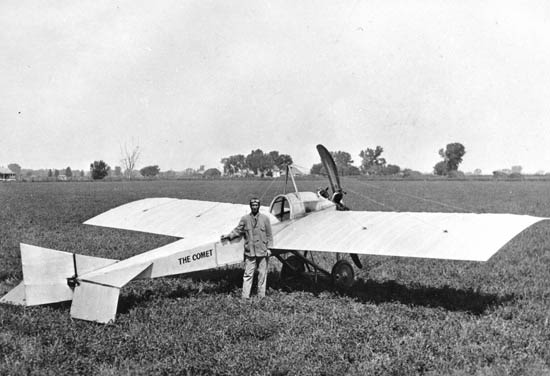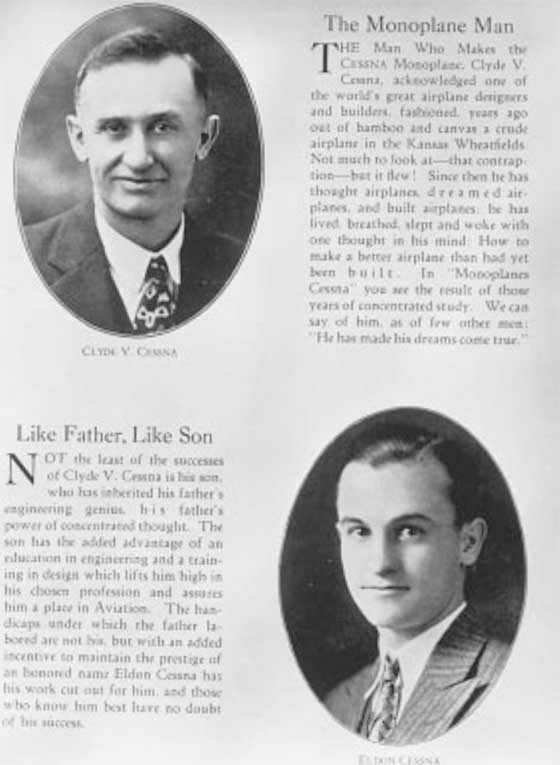|
Clyde Cessna founded the Cessna Aircraft Company, which endures
to this day (image, left, from Rodengen).
All totaled, 33 Cessna aircraft landed at the Davis-Monthan
Airfield between 1925 and 1936. For a brief chronology of
the Cessna company see this link.
Clyde Cessna was born December 5, 1878 in Hawthorne, IA.
He learned to fly before December 17, 1919, which qualified him for membership in the exclusive club known as the Early Birds of Aviation.
He landed once at Tucson on September 11, 1928 as part of
the entourage of competitors in the 1928 National Air Races.
He arrived from El Paso, TX, westbound to Yuma, AZ. He was
flying a Cessna Model A with Anzani engine, race number 97.
His signature can be found on page 60 of the Register, along
with those of 19 of his fellow racers. Follow this
link for the story of Team Cessna in the 1928 race.
Among aviators, Clyde Cessna hardly needs introduction or
embellishment. For a short biography see this link.
For the longer story, the following information is abstracted
from the Morehouse biographies cited at the left.
Young Clyde was mechanically inclined. By age 31 in 1910
he was head of the Overland Automobile Agency at Enid, OK,
where he sold over 100 cars. In 1910 he saw airplanes flying
at Oklahoma City. He decided to build a plane and learn to
fly.
Monoplanes interested him the most, so he proceeded to build
a Bleriot-type airframe at a rented workspace. He completed
it, with a 60HP water-cooled engine, by May, 1911. He first
flew it on June 9th, but crashed it, with no injuries to himself,
on his second attempt. He repaired it and crashed again on
his third attempt, and was sent to the hospital for “some
time.”
Through the winter of 1911-12 he recuperated and built a
new airplane at the farm he owned in Rago, KS. This airplane,
named Silver Wings, was tested and adjusted and flown in exhibitions
during the summer.
Between 1913 and 1917 he built a new airplane every winter
for the following season’s exhibition work at carnivals
and fairs throughout Kansas and Oklahoma. On his 1914 plane,
he used a windshield for the first time. Each craft he built
had better landing gear than the one before, as the landing
gear was a problem on the rough, unimproved landing areas
he used during exhibitions. Below, courtesy of the San Diego Aerospace Museum (SDAM), is one of the 14 different aircraft Cessna built between 1911 and ca. 1920. It's named "The Comet." Does anyone KNOW the exact date of this model?
Clyde Cessna Stands By "The Comet," Exact Date & Location Unknown (Source: SDAM)
 |
C.V. Cessna Obituary, The New York Times, November 22, 1954 (Source: NYT)
 |
Please direct your browser to the following links to view later models of Cessna's airplanes that landed at Tucson: NC7107, NC5035, NC5336.
In the fall of 1916, Cessna took over the Jones Motor Car
Company in Wichita, KS, and that winter built the first two
airplanes ever made in that city. He employed five men. Both
aircraft were monoplanes. World War I intervened and he operated
his Rago farm during the war.
After the war, cheaply available surplus airplanes diluted
the market for civilian-built craft. Barnstorming replaced
formal exhibitions, and Cessna marked time working his farm.
Meantime, in 1923, the Swallow Aeroplane Company (E.M. Laird,
proprietor) opened for business in Wichita. Walter Beech and
Lloyd Stearman were officers of the new Swallow Company.
Toward the end of 1924, Beech and Stearman resigned from
Swallow and planned to start another firm. They approached
Clyde Cessna and offered him the presidency of the new business.
In 1925 they established the Travel Air Company with Cessna
as president, Beech V.P., and Lloyd Stearman as Chief Engineer.
In 1926, they made 46 aircraft, but Cessna and Beech were
beginning to disagree on plane types. Cessna had always favored
monoplanes, but Beech insisted on biplanes. In 1927, Cessna
wanted to build a full cantilever Travel Air monoplane, but
Beech would not agree. Cessna sold his stock to Beech in April
and resigned from the company. He bought a shop in Wichita
and started to work on that aircraft, a 4-place, cabin monoplane,
powered by a 120HP Anzani engine, that he called the “Comet”.
Later that year the Cessna Aircraft Company was founded.
Over the next year, several models of monoplanes were designed,
46 were built, and 96 more were on order. In 1929, Cessna
outsourced sales to the Curtiss Flying Service, the Board
of Directors approved the purchase of 80 acres of land outside
Wichita to build a new factory, and 50,000 shares of new stock
were sold to finance the expansion.
Then, on October 29, 1929 the stock market crashed. Curtiss
went bankrupt. Cessna found himself with a new factory, huge
debt and no sales infrastructure. But he didn’t give
up. The glider movement showed promise, and, building a design
by his son, Eldon, he offered a primary glider for $398 and
sold over 300 of them.
The company sold a few airplanes and gliders through 1930.
In 1931, with Eldon, they built race planes for nationally
known pilots. This activity kept them solvent until 1933,
when Clyde’s nephew, Dwane Wallace, a young graduate
aeronautical engineer, approached him about reopening the
plant to resume building airplanes. On January 10, 1934 the
company was reopened with Cessna a president, Roscoe Vaughn
(see below) V.P. and Dwane Wallace as Plant Manager.
By 1935, Cessna was 56 years old and wanting to retire back
to his farm. In December he sold his stock to the directors,
but remained president until 1936 when he finally retired
to his farm and raised beef cattle.
Clyde Cessna passed away at age 75 on November 20, 1954 at
his home in Rago, KS. He had been living alert and active
on his farm, in semi-retirement, the last few years before
his death. His passing occurred 43 years after he produced
his first airplane, which he flew in Oklahoma in 1911.
Above abridged from: Morehouse Collection (see left column). His obituary from The New York Times of November 22, 1954 is at right.
---o0o---
Clyde Cessna was the father of Eldon. Son Eldon, born May 5, 1907, landed at Tucson
on August 19, 1931 flying Cessna aircraft NC7107. He carried
Roscoe Vaughn as passenger. Vaughn was to become V.P. of Cessna
Aircraft in 1934 (see above). Below, from a Cessna company brochure ca. 1928, we have both father and son on one page. The following two photographs come to us from Eldon's daughter, cited in the right sidebar.
Clyde (Top) & Eldon Cessna, ca. 1928
(Source: Clarke)
 |
In 1930, the design and manufacture of his CG-2 glider and,
later, racing aircraft, helped pull his family company out
of financial straits brought on by the Great Depression. Indeed, his visit to Tucson, above, was in conjunction with his competition in the 1931 National Air Races that began at Santa Monica, CA on August 29th and ended at Cleveland, OH September 7th. According to the Aircraft Yearbook, Eldon placed third in the Transcontinental Handicap Air Derby from Santa Monica to Cleveland. He won $1,200 for his effort.
Below, Eldon Cessna in a Cessna glider. The photograph was probably taken sometime between 1932 and 1933.
Eldon Cessna in Company-Built Glider, Date & Location Unknown
(Source: Clarke)
 |
The Washington Herald of August 24, 1932 reports Eldon holding
the lead in the Cord Derby. He led the pack at Lubbock, TX,
at the end of a flight from El Paso, landing at 3:46PM CST.
The Washington Daily News of August 27 reports him in second
place as he departed Cincinnati, OH. It further reports that
he was forced down near Blanchester, OH by a, “…broken
rocker box.” Neither he nor the plane was injured. Regardless of this delay, the Aircraft Yearbook [op.cit.] of 1933 states that he maintained his place and finished second in the race, winning $500 for his effort.
After designing 32 of the company's early models, Eldon left Cessna Aircraft in 1934 and joined Douglas Aircraft
Co. as a design engineer. He went to North American Aviation
where he helped design the World War II-era P-51 Mustang and
the F-86 fighter jet used in the Korean War. He went to Rockwell
International in 1938 and remained until his retirement in
1969. He worked on aircraft designs that helped the U.S. military
through several armed conflicts.
Eldon Cessna, died in hospital at Inglewood, CA February
22, 1992 at age 84. His obituary in the New York Times of February 25, 1992, below, was very simple despite citing the significant contributions he made to both civil and military aviation. His gravesite in Belmont, KS is at the link. Eldon Cessna also landed once at Clover Field, Santa Monica, CA, Wednesday, August 19, 1931.
"Eldon Cessna, who designed airplanes that saved the Cessna Aircraft Company in the 1930's, died Saturday in a hospital. He was 84.
"Mr. Cessna was the son of the company's founder, Clyde Cessna. Cessna Aircraft, of Wichita, Kan., specializes in making small planes.
"In 1930, Eldon Cessna's CG-2 glider helped pull the company out of financial straits. He also designed the Cessna Air Master, the World War II-era P-51 Mustang and the F-86 fighter jet used in the Korean War
"He left Cessna Aircraft in 1934 and joined the Douglas Aircraft Company as a design engineer. In 1938, he went to North American Aviation -- later Rockwell International -- where he remained until his retirement in 1969.
"He is survived by his wife, two children and five grandchildren." |
---o0o---
UPLOADED: 12/23/05 REVISED: 10/05/09, 09/20/11, 07/31/16
|






